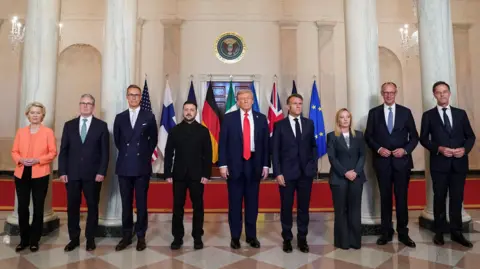On August 19, 2025, President Volodymyr Zelensky of Ukraine returned to the White House to engage in critical discussions with U.S. President Donald Trump, with a focus on addressing the ongoing conflict in Ukraine. This meeting also included several European leaders, coming on the heels of a summit between Trump and Russian President Vladimir Putin that took place in Alaska. The previous summit did not yield any agreements for a ceasefire, intensifying the urgency of the discussions in Washington.
Despite the optimistic rhetoric from President Trump and the more cautious responses from his European counterparts, the talks concluded without concrete commitments focused on security guarantees for Ukraine or actionable steps toward achieving a peace agreement.
One of the noteworthy moments from the meeting was a suggestion made by Trump regarding a future face-to-face meeting between Putin and Zelensky. According to a post shared on Truth Social, Trump indicated that he had initiated talks with Putin to arrange bilateral discussions, with plans for a trilateral meeting involving himself afterward. This potential meeting is significant, as it would mark the first direct engagement between the two leaders since Russia’s invasion of Ukraine began in February 2022, although past attempts to organize such meetings have been thwarted by Moscow’s reluctance.
During the proceedings, the European leaders were assertive regarding the need for a ceasefire, a crucial demand from Ukraine that Trump seemed to downplay. Previously, Zelensky had insisted that any cessation of hostilities must occur before negotiations could resume to ensure lasting peace. Trump, however, expressed skepticism about the necessity of an immediate ceasefire as a precursor to further dialogue, indicating a divergence in perspectives.
Germany’s Chancellor Friedrich Merz presented the strongest rebuttal, suggesting that any forthcoming meetings should prioritize reaching a ceasefire. In contrast, Zelensky chose not to reiterate his calls for a ceasefire during the meeting, which may reflect the complexity and sensitivities surrounding the ongoing negotiations.
In terms of security commitments, Trump assured Zelensky of U.S. support in any forthcoming agreements intended to end the war. Although he did not specify the exact nature of assistance – notably refraining from committing U.S. troops to Ukraine – he did imply that the U.S. would play a role in providing protection. Emphasizing that Europe would serve as the “first line of defense,” Trump reinforced the notion that the U.S. would remain involved in the security guarantees for Ukraine.
This clarification from Trump was unprecedented, showcasing a more decisive stance on the subject of security assurances, which are pivotal for Ukraine’s position in any peace negotiations. The agreement was to involve plans for a $90 billion arms package aimed at enhancing Ukraine’s military capabilities, which would encompass advanced weaponry and facilitate the production of unmanned drones in Ukraine.
Furthermore, Zelensky made efforts to mend relations during this visit, extending personal touches by delivering a letter from Ukraine’s First Lady to Melania Trump. This contrasted with past tensions during his previous meetings with U.S. officials, where Zelensky faced criticism over his demeanor and attire. The Ukrainian leader’s more diplomatic approach indicated a desire to improve rapport with American leaders.
As the discussions unfolded, European leaders collectively appreciated Trump’s initiative in assembling the talks, yet underscored their awareness of the security risks posed by Russia, which resonate throughout Europe.
Overall, the talks in Washington epitomize the intricate interplay of diplomacy surrounding the ongoing war in Ukraine, as various leaders navigate their respective positions on urgent issues such as ceasefires, security guarantees, and direct engagements with Russia. As the region remains volatile, the significance of these discussions only amplifies the global stakes involved in resolving this multifaceted crisis.












